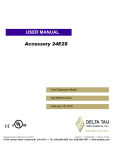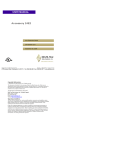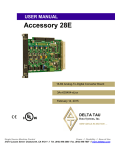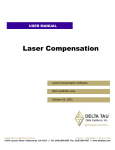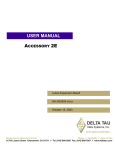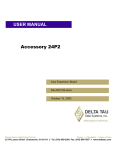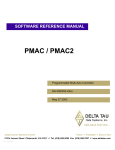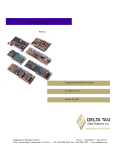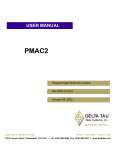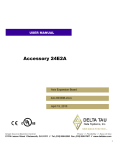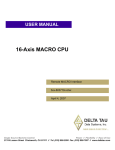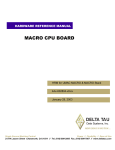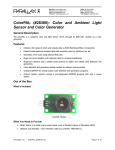Download ACC-24E2S___________________________Axis Expansion
Transcript
^1 USER MANUAL
^2 Accessory 24E2S
^3 Axis Expansion Board
^4 3Ax-603441-xUxx
^5 October 10, 2003
Single Source Machine Control
Power // Flexibility // Ease of Use
21314 Lassen Street Chatsworth, CA 91311 // Tel. (818) 998-2095 Fax. (818) 998-7807 // www.deltatau.com
Copyright Information
© 2003 Delta Tau Data Systems, Inc. All rights reserved.
This document is furnished for the customers of Delta Tau Data Systems, Inc. Other uses are
unauthorized without written permission of Delta Tau Data Systems, Inc. Information contained in
this manual may be updated from time-to-time due to product improvements, etc., and may not
conform in every respect to former issues.
To report errors or inconsistencies, call or email:
Delta Tau Data Systems, Inc. Technical Support
Phone: (818) 717-5656
Fax: (818) 998-7807
Email: support@deltatau.com
Website: http://www.deltatau.com
Operating Conditions
All Delta Tau Data Systems, Inc. motion controller products, accessories, and amplifiers contain
static sensitive components that can be damaged by incorrect handling. When installing or handling
Delta Tau Data Systems, Inc. products, avoid contact with highly insulated materials. Only
qualified personnel should be allowed to handle this equipment.
In the case of industrial applications, we expect our products to be protected from hazardous or
conductive materials and/or environments that could cause harm to the controller by damaging
components or causing electrical shorts. When our products are used in an industrial environment,
install them into an industrial electrical cabinet or industrial PC to protect them from excessive or
corrosive moisture, abnormal ambient temperatures, and conductive materials. If Delta Tau Data
Systems, Inc. products are directly exposed to hazardous or conductive materials and/or
environments, we cannot guarantee their operation.
Accessory 24E2S
Table of Contents
INTRODUCTION .......................................................................................................................................................1
Overview ...................................................................................................................................................................1
Features .....................................................................................................................................................................1
Board Configuration..................................................................................................................................................1
E-POINT JUMPER SETTINGS ................................................................................................................................3
ACC-24E2S Jumpers* ..............................................................................................................................................3
HARDWARE SETUP .................................................................................................................................................5
Switch Configuration ................................................................................................................................................5
UMAC Address DIP Switch S1 .............................................................................................................................5
MACRO Station Address DIP Switch S1 ..............................................................................................................5
ACC-24E2 Clock Settings.........................................................................................................................................5
Resistor Pack Configuration......................................................................................................................................6
Differential or Single-Ended Encoder Selection...................................................................................................6
Termination Resistors...........................................................................................................................................6
ACC-24E2 Limit and Flag Wiring ............................................................................................................................7
Connecting Limits/Flags to the ACC-24E2 ..........................................................................................................8
Loss of Encoder Circuit.............................................................................................................................................8
ACC-24E2S Discrete On-board Logic with UMAC Turbo CPU..........................................................................8
ACC-24E2S Discrete On-board Logic with UMAC MACRO CPU ......................................................................9
Position Compare Port Driver IC ..............................................................................................................................9
CONNECTIONS .......................................................................................................................................................11
ACC-24E2S Terminal Block Layout Diagram .......................................................................................................11
ACC-24E2S DB15 Option Layout Diagram ...........................................................................................................11
Mating Connectors ..................................................................................................................................................12
Terminal Block Connectors ................................................................................................................................12
DB15 Connector Option .....................................................................................................................................12
Indicators.................................................................................................................................................................12
Sample Wiring Diagrams ........................................................................................................................................13
TTL Level Inputs and Outputs ............................................................................................................................13
ACC-24E2S Stepper Motor Outputs (TTL level) ................................................................................................14
Position Limits, Home Flag, and User Flag.......................................................................................................14
UMAC SOFTWARE SETUP ...................................................................................................................................15
System Configuration I-Variables...........................................................................................................................15
Servo IC Configuration I-Variables ........................................................................................................................15
Servo IC Numbering ...........................................................................................................................................15
Servo Channel Numbering..................................................................................................................................15
Multi-Channel I-Variables..................................................................................................................................16
Single-Channel I-Variables ................................................................................................................................17
Encoder Conversion Table I-Variables ..............................................................................................................17
Motor Addressing I-Variables ............................................................................................................................18
UMAC Turbo Example Setups ...............................................................................................................................20
ULTRALITE/MACRO STATION SETUP ............................................................................................................21
Hardware Setup for MACRO Station Use ..............................................................................................................21
Node-Specific Gate Array MI-variables .............................................................................................................21
Encoder/Timer n Decode Control (MSn,MI910) ....................................................................................................21
Flag Capture Control (MSn,MI911-MI913)............................................................................................................22
Output Mode Select (MSn,MI916)..........................................................................................................................23
MACRO Station Encoder Conversion Table (MSn,MI120-MI151) .......................................................................24
Using ACC-24E2S with the MACRO Station/Ultralite or Turbo Ultralite Change Output Mode to PFM on the
Third Channel..........................................................................................................................................................24
PMAC2 Ultralite.................................................................................................................................................24
Table of Contents
i
Accessory 24E2S
PMAC2 Turbo Ultralite MACRO IC0 ................................................................................................................25
PMAC2 Turbo Ultralite MACRO IC1 ................................................................................................................25
PMAC2 Turbo Ultralite MACRO IC2 ................................................................................................................25
PMAC2 Turbo Ultralite MACRO IC3 ................................................................................................................25
MOTOR PARAMETER SETUP FOR UMAC AND MACRO ............................................................................27
PMAC2 Motor Servo Gain I-variables for Stepper Motors ....................................................................................27
Ix30 Motor x Proportional Gain.........................................................................................................................27
Ix31 Motor x Derivative Gain.............................................................................................................................27
Ix32 Motor x Velocity Feedforward Gain...........................................................................................................27
Ix33 Motor x Integral Gain.................................................................................................................................28
Ix34 Motor x Integration Mode...........................................................................................................................28
Ix35 Motor x Acceleration Feedforward Gain ...................................................................................................28
MLDT FEEDBACK FOR UMAC-TURBO & UMAC-MACRO .........................................................................29
MLDT Hardware Setup of the ACC-24E2S............................................................................................................29
MLDT Software Setup of the UMAC Turbo ..........................................................................................................29
Hardware Setup I-Variables for Servo IC m ......................................................................................................29
Conversion Table Processing I-Variables ..........................................................................................................29
Motor I-Variables ...............................................................................................................................................30
Pulse Output Frequency .....................................................................................................................................31
PMAC2/Turbo PMAC2 Conversion Table & Motor I-Variables .......................................................................32
MLDT Feedback for UMAC-MACRO...................................................................................................................33
MLDT Software Setup of the UMAC MACRO....................................................................................................33
Station Hardware Setup I-Variables for Servo IC ..............................................................................................33
Station Conversion Table Processing I-Variables..............................................................................................33
Station Motor Node I-Variables .........................................................................................................................34
Power-On Feedback Address for PMAC2 Ultralite ...........................................................................................35
MACRO Parallel Absolute Position Setup..........................................................................................................36
Example MLDT Setup for UMAC-MACRO ........................................................................................................37
ACC-24E2S TERMINAL BLOCK DESCRIPTION..............................................................................................39
Connector TB1 Top – Output1/Encoder 1 ..........................................................................................................39
Connector TB2 Top – Output2/Encoder 2 ..........................................................................................................39
Connector TB3 Top – EQU Outputs...................................................................................................................39
Connector TB1 Bottom Encoder 3......................................................................................................................40
Connector TB2 Bottom Encoder 4......................................................................................................................40
Connector TB3 Bottom- Compare Outputs.........................................................................................................40
Connector TB1 Front- Limits 1 ..........................................................................................................................41
DB15 Style Connector J1 Top - Encoder 1 / EQU..................................................................................................41
DB15 Style Connector J2 Top - Encoder 2 / EQU..................................................................................................42
DB15 Style Connector J1 Bottom - Encoder 3 / EQU ............................................................................................42
DB15 Style Connector J2 Bottom - Encoder 4 / EQU ............................................................................................43
UBUS PINOUTS........................................................................................................................................................45
P1 UBUS (96-Pin Header) ................................................................................................................................45
ii
Table of Contents
Accessory-24E2S
INTRODUCTION
Overview
The ACC-24E2S Axis Expansion Board provides four channels of PMAC2-style stepper interface and/or
encoder/MLDT circuitry for UMAC and Ultralite/MACRO Station controllers. The ACC-24E2S is part
of the UMAC or MACRO Pack family of expansion cards and these accessory cards are designed to plug
into an industrial 3U rack system. The information from these accessories is passed directly to either the
UMAC or MACRO Station CPU via the high speed UBUS. Other axis or feedback interface accessories
include the following:
ACC-14E
ACC-24E2
ACC-24E2A
ACC-24E2S
ACC-28E
ACC-51E
ACC-53E
Parallel Feedback Inputs (absolute enc. or interferometers)
Digital Amplifier Breakout w/ TTL encoder inputs
Analog Amplifier Breakout w/ TTL encoder inputs
Stepper Amplifier Breakout w/ TTL encoder inputs
16-bit A/D Converter Inputs (up to four per card)
4096 times interpolator for 1Vpp sinusoidal encoders
SSI encoder interface (up to 8 channels)
The step and direction outputs are RS422 compatible and are capable of being connected in either
differential mode or single ended configurations for 5V input drivers. Flag input terminals are provided
to allow connection of 12V-24V sensors or limit switches.
Up to eight ACC-24E2S boards can be connected to one UMAC providing up to 32 additional channels
of stepper interface circuitry. Because each MACRO Station CPU can service only eight channels of
servo data, only two ACC24E2S boards can be connected to the MACRO Station for stepper motor
connection.
The ACC-24E2S is also an ideal board to use for dual feedback systems because it can process four
encoders with one single board on the 3U rack.
The ACC-24E2S board contains no processor; it has one highly integrated 4-channel PMAC2-style Servo
IC with the buffering circuitry and connectors around them. The four-axis ACC-24E2S plugs into the
backplane and uses one slot in the Rack.
Features
The ACC-24E2S board can be used with any UMAC or MACRO Station CPU, interfacing through the
Expansion port.
The ACC-24E2S can only support pulse and direction commands from the controller.
Board Configuration
An ACC-24E2S comes standard with one Servo IC providing four servo interface channels, which are
brought out on terminal blocks. Each channel of servo interface circuitry includes the following:
•
•
•
Four output command signal sets, configurable as pulse and direction outputs only:
Four 3-channel differential/single-ended encoder input
Four sets of five input flags and one compare output flag
Introduction
1
Accessory 24E2S
2
Introduction
Accessory-24E2S
E-POINT JUMPER SETTINGS
ACC-24E2S Jumpers*
Jumper
Configuration
E1
1-2
Description
Default
Jumper 1-2 for Stepper Mode Output for Channel 1
Jump 1-2
No jumper for Channel 1 TUVW inputs.
E2
1-2
Jumper 1-2 for Stepper Mode Output for Channel 2
Jump 1-2
No Jumper for Channel 2 TUVW inputs.
E3
1-2
Jumper 1-2 for Stepper Mode Output for Channel 3
Jump 1-2
No Jumper for Channel 3 TUVW inputs.
E4
1-2
Jumper 1-2 for Stepper Mode Output for Channel 4
Jump 1-2
No Jumper for Channel 4 TUVW inputs.
Jump 1-2
E5
1-2-3
Jump 1-2 for Turbo 3U CPU and MACRO CPU
** Jump 2-3 for legacy MACRO CPU (before 6/00)
E11
1-2
Jump 1-2 to enable AENA1
Jump 1-2
No Jumper to disable AENA1
E12
1-2
Jump 1-2 to enable AENA2
Jump 1-2
No Jumper to disable AENA2
E13
1-2
Jump 1-2 to enable AENA3
Jump 1-2
No Jumper to disable AENA3
E14
1-2
Jump 1-2 to enable AENA4
Jump 1-2
No Jumper to disable AENA4
E16
1-2-3
Jump 1-2 to receive phase and servo clocks
Factory set
Jump 2-3 to transmit phase and servo clocks
OPT1
1-2
For factory use only
OPT2
1-2
For factory use only
OPT3
1-2
For factory use only
*The channels refer to the Servo IC associated with the individual ACC-24E2S board. For example in
an eight-axis application, there would be two ACC-24E2S boards. The first ACC-24E2S would have
axes 1-4 and the second ACC-24E2S would contain axes 5-8.
** For legacy MACRO Stations (part number 602804-100 through 602804-104)
Note:
Delta Tau added the amplifier enable outputs with the release of the 603441-101
revision of the ACC-24E2S card and jumpers E11, E12, E13, and E14 were added
for this feature. The first revision of this accessory (603441-100) does not have
amplifier enable outputs or jumpers E11, E12, E13, or E14.
E-Point Jumper Settings
3
Accessory 24E2S
4
E-Point Jumper Settings
Accessory-24E2S
HARDWARE SETUP
Switch Configuration
UMAC Address DIP Switch S1
S1-1
S1-3
S1-4
Board No.
IC No.
I-Variable
Range
Base
Address
ON
ON
ON
1
2
I7200
$078200
OFF
ON
ON
2
3
I7300
$078300
ON
OFF
ON
3
4
I7400
$079200
OFF
OFF
ON
4
5
I7500
$079300
ON
ON
OFF
5
6
I7600
$07A200
OFF
ON
OFF
6
7
I7700
$07A300
ON
OFF
OFF
7
8
I7800
$07B200
OFF
OFF
OFF
8
9
I7900
$07B300
S1, S1-3, S1-4 are used to address the ACC-24E2S as shown in this table.
S1-2
S1-5
S1-6
Function
ON
ON
ON
3U Turbo PMAC Use
S1-2, S1-5, and S1-6 are used to determine whether the ACC-24E2S is
communicating to a Turbo 3U PMAC or a MACRO Station CPU.
MACRO Station Address DIP Switch S1
S1-1, S1-2, S1-3, S1-4 are used to address the ACC-24E2 as shown in the table below.
S1-1
S1-2*
S1-3
S1-4
Board No.
IC No.
Base Address
ON
ON
OFF
OFF
1
2
$00C040
OFF
OFF
OFF
OFF
2
3
$00C060
* Always set to OFF for legacy MACRO Stations (part number 602804-100 thru 602804-104)
S1-5, and S1-6 are used to determine whether the ACC-24E2 is communicating to a Turbo 3U PMAC or
a MACRO Station CPU.
S1-5
S1-6
Function
OFF
OFF
3U MACRO Station use
ACC-24E2 Clock Settings
The Phase Clock and Servo Clock must be configured on each ACC-24E2S. Each system can have only
one source for the servo and phase clocks and jumpers must be set appropriately to avoid a timing conflict
or a watchdog condition.
Starting in UMAC-Turbo firmware version 1.937, the firmware will set the clock settings automatically
for the ACC-24E2 cards in the UBUS. To enable this feature, set jumper E16 from 2 to 3 for all of the
ACC-24E2Ss plugged into the UMAC. At re-initialization (either $$$*** command or power up with E3
jumpered on UMAC), the firmware will know that all of the cards are in the auto configuration setup and
will assign the card with the lowest base address setting (usually $78200) the task of sourcing the clocks
by setting variable I19 to the appropriate register. The clocks will be set initially to the factory default
servo update cycle and phase clock cycle. For a better understanding of this feature, refer to the
description of I19 in the Turbo Software Reference Manual.
For UMAC Turbo systems with firmware older than version 1.937, set one of the ACC-24E2’s to
transmit (E16 set 2-3) the phase and servo clock (usually the card at the lowest base address setting) and
set the rest of the ACC-24E2s to receive (E16 set 1-2) the phase and servo clocks.
For MACRO systems, the clock select jumper should be set to receive servo and phase clocks. For the
ACC-24E2S, E16 should be set 1-2.
UMAC Software Setup
5
Accessory 24E2S
Resistor Pack Configuration
Differential or Single-Ended Encoder Selection
The differential input signal pairs to the PMAC have user-configurable pull-up/pull-down resistor
networks to permit the acceptance of either single-ended or differential signals in one setting, or the
detection of lost differential signals in another setting.
•
•
The ‘+’ inputs of each differential pair each have a hard-wired 1 kΩ pull-up resistor to +5V. This
cannot be changed.
The ‘-’ inputs of each differential pair each have a hard-wired 2.2 kΩ resistor to +5V; also each has
another 2.2 kΩ resistor as part of a socketed resistor pack that can be configured as a pull-up resistor
to +5V, or a pull-down resistor to GND.
If this socketed resistor is configured as a pull-down resistor (the default configuration), the combination
of pull-up and pull-down resistors on this line acts as a voltage divider, holding the line at +2.5V in the
absence of an external signal. This configuration is required for single-ended inputs using the ‘+’ lines
alone; it is desirable for unconnected inputs to prevent the pick-up of spurious noise; it is permissible for
differential line-driver inputs.
If this socketed resistor is configured as a pull-up resistor (by reversing the SIP pack in the socket), the
two parallel 2.2 kΩ resistors act as a single 1.1 kΩ pull-up resistor, holding the line at +5V in the absence
of an external signal. This configuration is required if encoder-loss detection is desired; it is required if
complementary open-collector drivers are used; it is permissible for differential line-driver inputs even
without encoder loss detection.
If Pin 1 of the resistor pack (marked by a dot on the pack) matches Pin 1 of the socket (marked by a wide
white square solder pin on the front side of the board), then the pack is configured as a bank of pull-down
resistors. If the pack is reversed in the socket, it is configured as a bank of pull-up resistors.
The following table lists the pull-up/pull-down resistor pack for each input device:
Device
Resistor Pack
Pack Size
Encoder 1
Encoder 2
Encoder 3
Encoder 4
RP19
RP21
RP27
RP29
6-pin
6-pin
6-pin
6-pin
Termination Resistors
The ACC-24E2S provides sockets for termination resistors on differential input pairs coming into the
board. As shipped, there are no resistor packs in these sockets. If these signals are brought long distances
into the ACC-24E2A board and ringing at signal transitions is a problem, SIP resistor packs may be
mounted in these sockets to reduce or eliminate the ringing.
All termination resistor packs have independent resistors (no common connection) with each resistor
using two adjacent pins.
6
UMAC Software Setup
Accessory-24E2S
Channel Specific Resistor Packs
Channel 1
Channel 2
Channel 3
Channel 4
SIP
Description
RP19
RP23
RP21
RP22
RP27
RP28
RP29
RP30
2.2KΩ
220Ω
RP38
RP42
RP47
RP51
1KΩ
Reverse for encoder loss feature
Termination resistor to reduce ringing
(not installed by default).
Install for 5V limits
Channel Specific Resistor Packs
Resistor Pack
RP5
RP6
SIP
220Ω
220Ω
Description
Terminator (not installed, only used for non-UBUS)
Pull Down for Old MACRO CPU
Pull Up for UMAC Turbo & MACRO
ACC-24E2 Limit and Flag Wiring
The ACC-8F allows the use of sinking or sourcing position limits and flags to the PMAC2. The optoisolator IC used is a PS2705-4NEC-ND quad photo-transistor output type. This IC allows the current to
flow from return to flag (sinking) or from flag to return (sourcing).
A sample of the positive limit circuit is shown below. The 4.7K resistor packs used will allow 12-24V
flag inputs. If 0-5V flags are used, then a 1kΩ resistor pack (RP) can be placed in either RP38, RP42,
RP47, or RP51 (refer to the Resistor Pack Configuration section of this manual). If these resistor packs
are not added, all flags (±Limits, Home, User, and amplifier fault) will be referenced from 0-5V.
UMAC Software Setup
7
Accessory 24E2S
Connecting Limits/Flags to the ACC-24E2
The following diagram illustrates the sinking and sourcing connections to an ACC-24E2. This example
uses 12-24V flags.
Sinking,
Separate
Supply
Sourcing,
Separate
Supply
Loss of Encoder Circuit
The encoder-loss detection circuitry works for differential incremental encoders only. In proper
operation, the digital states of the complementary inputs for a channel (e.g. A and A/) always should be
opposite: when one is high, the other is low. If for some reason, such as a cable connection coming
undone, one or more of the signal lines is no longer driven, pull-up resistors on the input line pull and
hold the signal high.
The encoder-loss detection circuitry uses exclusive-or (XOR) gates on each complementary pair to detect
whether the signals are in the same or opposite states. These results are combined to produce a single
encoder-loss status bit that the processor can read.
In order to enable this function, the socketed resistor packs for the encoder must be reversed from their
factory default setting so that the complementary encoder lines A/, B/, and C/ are pulled up to 5V instead
of pulled to 2.5V. The resistor packs to be reversed are RP19, RP21, RP27, and RP29.
ACC-24E2S Discrete On-board Logic with UMAC Turbo CPU
Channel
Resistor
Pack
Status Bit Address
(Even-Numbered
Servo IC)*
Status Bit Address
(Odd-Numbered
Servo IC)*
Status
Bit
“Name”
Bit Error
State
1
RP19
Y:$07xF08,5
Y:$07xF0C,5
QL_10
2
RP21
Y:$07xF09,5
Y:$07xF0D,5
QL_20
3
RP27
Y:$07xF0A,5
Y:$07xF0E,5
QL_30
4
RP29
Y:$07xF0B,5
Y:$07xF0F,5
QL_40
*The x digit in this hex address matches the value (8, 9, A, or B) in the fourth digit from the right in
the board’s own base address (e.g. $079200). If alternate addressing of Servo ICs is used (e.g. Servo
IC 2*), add $20 to these addresses.
8
UMAC Software Setup
Accessory-24E2S
ACC-24E2S Discrete On-board Logic with UMAC MACRO CPU
Channel
Resistor
Pack
Status Bit Address
(First- Servo IC)*
Status Bit Address
(Second Servo
IC)*
Status
Bit
“Name”
Bit
Error
State
1
RP19
Y:$B8C8,5
Y:$B8CC,5
QL_12
RP21
Y:$B8C9,5
Y:$B8CD,5
QL_23
RP27
Y:$B8CA,5
Y:$B8CE,5
QL_34
RP29
Y:$B8CB,5
Y:$B8CF,5
QL_4*First Servo IC has base address $C040; second Servo IC has base address $C060.
0
0
0
0
Position Compare Port Driver IC
As with the other PMAC controllers, the UMAC has the high speed compare outputs allowing the firing
of an output based on position. This circuit will fire within 100 nsec of reaching the desired position.
The position compare output port on the ACC-24E2 and its Option 1 daughter card has a socketed driver
IC in a 8-pin DIP socket at component U27. This IC gives a fast CMOS driver.
The following table lists the properties of each driver IC:
Part
# of Pins
Max Voltage &
Current
Output Type
Max Frequency
DS75451N
8
5V, 10 mA
Totem-Pole
(CMOS)
5 MHz
UMAC Software Setup
9
Accessory 24E2S
10
UMAC Software Setup
Accessory-24E2S
CONNECTIONS
ACC-24E2S Terminal Block Layout Diagram
Designates Pin 1
ACC-24E2S DB15 Option Layout Diagram
1
12 11 10 9
J1
8
7
6
1
TOP
5
4
3
2
1
A B C
12 11 10 9
J2
8
7
6
5
4
3
2
1
P1
1
2
3
4
5
6
7
J2
UMAC Software Setup
8
9 10 11 12
1
C B A
1
BOTTOM
2
3
4
5
6
7
J1
8
9 10 11 12
1
11
Accessory 24E2S
Mating Connectors
Terminal Block Connectors
Name
Manufacturer
Pins
TB1- Top
TB2- Top
TB3- Top
TB1- Bottom
TB2- Bottom
TB3- Bottom
TB1- Front
Phoenix Contact
Phoenix Contact
Phoenix Contact
Phoenix Contact
Phoenix Contact
Phoenix Contact
Phoenix Contact
12
12
3
12
12
3
20
Type
Details
FRONT-MC1,5/12-ST3,81
FRONT-MC1,5/12-ST3,81
FRONT-MC1,5/3-ST3,81
FRONT-MC1,5/12-ST3,81
FRONT-MC1,5/12-ST3,81
FRONT-MC1,5/3-ST3,81
FRONT-MC1,5/20-ST3,81
Encoder 1 Inputs
Encoder 2 Inputs
Compare Outputs
Encoder 3 Inputs
Encoder 4 Inputs
Compare Outputs
Flags
DB15 Connector Option
Name
Manufacturer
Pins
Type
Details
J1- Top
AMP
15
AMP 745072-2
J2- Top
AMP
15
AMP 745072-2
J1- Bottom
AMP
15
AMP 745072-2
J2- Bottom
AMP
15
AMP 745072-2
Encoder 1 Inputs and
Compare Outputs
Encoder 2 Inputs and
Compare Outputs
Encoder 3 Inputs and
Compare Outputs
Encoder 4 Inputs and
Compare Outputs
Indicators
12
LED
Color
Description
D11
D12
Green
Green
Encoder 1 & 2 Power OK
Encoder 3 & 4 Power OK
UMAC Software Setup
Accessory-24E2S
Sample Wiring Diagrams
This section has typical wiring diagrams for the TTL level inputs, flags and limits, PFM outputs.
TTL Level Inputs and Outputs
Quadrature Encoders
8
15
BEQU2
BEQU1
GND
A
A/
B
B/
C
C/
5V
GND
U
V
W
T
Shield
1
2
3
4
5
6
7
8
9
10
11
12
A
A/
B
B/
C
C/
5V
GND
U
V
W
T
Encoder
Float Shield
Shield
Encoder
Float Shield
9
1
U
TTL Hall Effect Sensors
V
W
5 4
6
2
3
1
8
BEQU2
BEQU1
GND
A
A/
B
B/
C
C/
5V
GND
U
V
W
T
15
A
A/
B
B/
C
C/
5V
GND
U
V
W
T
1
2
3
4
5
6
7
8
9
10
11
12
Float Shield
Hall
Sensor
Shield
Float Shield
Hall
Sensor
9
Shield
1
Position Compare Outputs
5V
Output Device 2
8
0V
15
BEQU2
BEQU1
GND
A
A/
B
B/
C
C/
5V
GND
U
V
W
T
3
2
1
GND
BEQU1
BEQU2
Output Device 1
Output Device 2
Output Device 1
9
1
UMAC Software Setup
13
Accessory 24E2S
ACC-24E2S Stepper Motor Outputs (TTL level)
ACC-24E2S PFM -Stepper Output
Bus Voltage
8
2
3
4
5
6
7
8
9
10
11
12
Bus Voltage
A
A/
B
B/
AENA+
AENA5V
GND
Dir+
DirPulse+
Pulse-
BEQU2
BEQU1
GND
A
A/
B
B/
AENA+
AENA5V
GND
Dir+
DirPulse+
Pulse-
15
1
Stepper
Amplifier
Stepper
Amplifier
9
1
Channel1: Jumper E1 &
Channel2: Jumper E2 &
Channel3: Jumper E3 &
Channel4: Jumper E4 &
E11
E12
E13
E14
*E11, E12, E13, and E14 are for
Amp enable
Step
Motor
Channel1: Jumper E1 & E11
Channel2: Jumper E2 & E12
Channel3: Jumper E3 & E13
Channel4: Jumper E4 & E14
Step
Motor
*E11, E12, E13, and E14 are for
Amp enable
Position Limits, Home Flag, and User Flag
ACC-24E2S Sourcing Flags
20
19
18
19
18
17
16
24V Supply
15
17
16
14
13
13
12
11
12
11
0V
24V
0V
10
9
9
8
8
7
24V Supply
15
14
10
14
ACC-24E2S Sinking Flags
20
24V
7
6
5
FLG_RTN_1
4
HOME1
3
MLIM1
3
2
PLIM1
2
PLIM1
1
USER1
1
USER1
Home
Neg
6
5
FLG_RTN_1
4
HOME1
Home
MLIM1
Neg
Pos
Pos
User
User
UMAC Software Setup
Accessory-24E2S
UMAC SOFTWARE SETUP
System Configuration I-Variables
Starting in Turbo PMAC firmware version V1.934, the Turbo PMAC determines automatically which
Servo and MACRO ICs are present on power-up/reset and enables the I-variables for these ICs.
In previous versions, I65 had to be set manually to tell the Turbo PMAC which ICs were present so that
the proper I-variables could be enabled. In V1.934 and newer versions, Turbo PMAC reports which ICs
are present in read-only variable I4900. If using a Turbo PMAC with firmware 1.933 and below, refer to
the Turbo PMAC Software Reference Manual for a detailed description of these system configuration Ivariables.
Servo IC Configuration I-Variables
Turbo PMAC I-variables in the range I7000 – I7999 control the configuration of the Servo ICs. The
hundreds digit represents the number of the Servo IC (0 to 9) in the system. Servo ICs 0 and 1 are (or can
be) on board the Turbo PMAC board itself. Servo ICs 2 through 9 are (or can be) on external devices
such as the ACC-24E2.
Servo IC Numbering
The number m of the Servo IC on the ACC-24E2 board is dependent on the addressing of the board with
DIP switches S1-1, S1-3, and S1-4, which place the board as the first through eighth external devices:
•
•
•
•
•
•
•
•
First ACC-24E2 with option 1:
Second ACC-24E2 with option 1
Third ACC-24E2 with option 1:
Fourth ACC-24E2 with option 1
Fifth ACC-24E2 with option 1:
Sixth ACC-24E2 with option 1
Seventh ACC-24E2 with option 1:
Eighth ACC-24E2 with option 1
Servo IC 2 (channels 1-4)
Servo IC 3 (channels 5-8)
Servo IC 4 (channels 9-12)
Servo IC 5 (channels 13-16)
Servo IC 6 (channels 17-20)
Servo IC 7 (channels 21-24)
Servo IC 8 (channels 25-28)
Servo IC 9 (channels 29-32)
The Standard Servo IC on an ACC-24E2 occupies Channels 1 through 4 on the board.
Example: The Standard Servo IC on the first ACC-24E2 is Servo IC 2 to Turbo PMAC and is configured
by variables I7200 – I7299.
Servo Channel Numbering
Each Servo IC has four channels of servo interface circuitry. The tens digit n of the I-variable
configuring the IC represents the channel number on the IC (n = 1 to 4). For example, Channel 1 of the
Standard Servo IC on the first ACC-24E2 is configured by variables I7210 – I7219. These channelspecific I-variables are represented generically as I7mn0 – I7mn9, where m represents the Servo IC
number (0 – 9) and n represents the IC channel number (1 – 4).
The Channels 1 – 4 on the Standard Servo IC of an ACC-24E2 correspond to Channels 1 – 4,
respectively, on the ACC-24E2 board itself. The Channels 1 – 4 on the Option 1 Servo IC on an ACC24E2 correspond to Channels 5 – 8, respectively, on the ACC-24E2 board.
I-variables in the I7000s for which the tens digit is 0 (Channel 0) affect all four channels of the PMAC2style Servo IC on the ACC-24E2. These multi-channel I-variables are represented generically as I7m00 –
I7m09.
UMAC Software Setup
15
Accessory 24E2S
Multi-Channel I-Variables
There are several multi-channel I-variables that must be set up properly for proper operation of the ACC24E2 in a Turbo PMAC system. The most important are:
I7m07: Servo IC m Phase/Servo Clock Direction
This variable should be set to 3 for any Servo IC on an ACC-24E2 so it inputs its phase and servo clocks
from signals generated on the Turbo PMAC itself.
I7m00: Servo IC m MaxPhase/PWM Frequency Control
Typically, this will be set to the same value as the variable that controls the system clocks: I7000 on a
non-Ultralite Turbo PMAC2, or I6800 on a Turbo PMAC2 Ultralite. If a different PWM frequency is
desired, or the ACC-24E2 is used with a Turbo PMAC(1) in which the system clock frequencies are set
by jumpers, then the following constraint should be observed in setting this variable:
2 * PWMFreq( kHz )
PhaseFreq
= { Integer }
I7m01: Servo IC m Phase Clock Frequency Control
Even though the IC is receiving an external phase clock (see I7m07, above), usually it is best to create the
same internal phase clock frequency in the Servo IC. This yields the following constraint:
I 7 m00 * ( I 7 m01 + 1 ) = I 7000 * ( I 7001 + 1 )
I 7 m00 * ( I 7 m01 + 1 ) = I 6800 * ( I 6801 + 1 )
{Non-Ultralite Turbo PMAC2}
{Turbo PMAC2 Ultralite}
Solving for I7m01, the result is:
I 7 m01 =
I 7 m01 =
I 7000 * ( I 7001 + 1 )
I 7 m00
I 6800 * ( I 6801 + 1 )
I 7 m00
−1
{Non-Ultralite PMAC2}
−1
{Turbo PMAC2 Ultralite}
If I7m00 is the same as I7000 or I6800, I7m01 will be the same as I7001 or I6801. If the ACC-24E2 is
interfaced to a Turbo PMAC(1) board, it should be set by calculation to obtain the same phase clock
frequency as that set by the jumpers on the Turbo PMAC(1).
I7m02: Servo IC m Servo Clock Frequency Control
Even though the IC is receiving an external servo clock (see I7m07, above), usually it is best to create the
same internal servo clock frequency in the Servo IC. This means that I7m02 for the IC should be set the
same as I7002 on a non-Ultralite Turbo PMAC2, or the same as I6802 on a Turbo PMAC2 Ultralite.
When connected to a Turbo PMAC(1), I7m02 should create the same division from the phase clock as
jumpers E3 – E6 do on the Turbo PMAC(1).
I7m03: Servo IC m Hardware Clock Frequency Control
The hardware clock frequencies for the Servo IC should be set according to the devices attached to it.
There is no reason that these frequencies have to be the same between ICs. There is seldom a reason to
change this value from the default.
16
UMAC Software Setup
Accessory-24E2S
Single-Channel I-Variables
The single-channel setup I-variables for Channel n of Servo IC m work the same on an ACC-24E2 as they
do on a Turbo PMAC2 itself. Each Servo IC has four channels n, numbered 1 to 4. For the first
(standard) Servo IC on the ACC-24E2, the channel numbers 1 – 4 on the Servo IC are the same as the
channel numbers 1 – 4 on the board. For the second (optional) Servo IC on the ACC-24E2, the channel
numbers 1 – 4 on the Servo IC correspond to board channel numbers 5 – 8. The most important variables
are:
I7mn0: Servo IC m Channel n Encoder Decode Control
Typically, I7mn0 is set to 3 or 7 for x4 quadrature decode, depending on which way is up. If the channel
is used for open-loop stepper drive, I7mn0 is set to 8 to accept internal pulse-and-direction, or to 0 to
accept external pulse-and-direction (e.g. from an ACC-8S). It is set to 12 if the channel is used for
MLDT feedback.
I7mn2: Servo IC m Channel n Capture Control
I7mn2 determines whether the encoder index channel, an input flag, or both, are used for the capture of
the encoder position.
I7mn3: Servo IC m Channel n Capture Flag Select
I7mn3 determines which input flag is used for encoder capture, if one is used.
I7mn6: Servo IC m Channel n Output Mode Select
I7mn6 determines whether the A and B outputs are DAC or PWM, and whether the C output is PFM
(pulse-and-direction) or PWM. Typically, it is set to 0, either for 3-phase PWM, or to 3 for DACs and
PFM.
Encoder Conversion Table I-Variables
To use feedback or master position data from an ACC-24E2, entries must be added to the encoder
conversion table (ECT) using I-variables I8000 – I8191 to address and process this data. The default
conversion table in the Turbo PMAC does not contain these entries; it only contains entries for the eight
channels on board the Turbo PMAC.
Usually, the position data obtained through an ACC-24E2 board is an incremental encoder feedback, and
occasionally an A/D converter feedback from an ACC-28B board connected through the ACC-24E2.
The ECT entries for ACC-24E2 incremental encoder channels are shown in the following table:
Servo
IC #
Chan. 1
Chan. 2
Chan. 3
Chan. 4
Notes
2
$m78200
$m78208
$m78210
$m78218
1st ACC-24E2x Channel n Encoder Set
3
$m78300
$m78308
$m78310
$m78318
2nd ACC-24E2x Channel n Encoder Set
4
$m79200
$m79208
$m79210
$m79218
3rd ACC-24E2x Channel n Encoder Set
5
$m79300
$m79308
$m79310
$m79318
4th ACC-24E2x Channel n Encoder Set
6
$m7A200 $m7A208 $m7A210 $m7A218
5th ACC-24E2x Channel n Encoder Set
7
$m7A300 $m7A308 $m7A310 $m7A318
6th ACC-24E2x Channel n Encoder Set
8
$m7B200 $m7B208 $m7B210 $m7B218
7th ACC-24E2x Channel n Encoder Set
9
$m7B300 $m7B308 $m7B310 $m7B318
8th ACC-24E2x Channel n Encoder Set
The first hexadecimal digit in the entry, represented by m in the table, is a 0 for the most common 1/T
timer-based extension of digital incremental encoders; it is an 8 for the parallel-data extension of analog
incremental encoders; it is a C for no extension of an incremental encoder.
UMAC Software Setup
17
Accessory 24E2S
Motor Addressing I-Variables
For a Turbo PMAC motor to use the servo interface circuitry of the ACC-24E2, several of the addressing
I-variables for the motor must contain the addresses of registers in the ACC-24E2, or the addresses of
encoder conversion table registers containing data processed from the ACC-24E2. These I-variables can
include:
Ixx02: Motor xx Command Output Address
Ixx02 tells Turbo PMAC where to write its command outputs for Motor xx. If ACC-24E2 is to create the
command signals, Ixx02 must contain the address of the register.
The following table shows the address of the C output register for each channel of each ACC-24E2S.
These addresses can be used for single analog outputs, double analog outputs, or direct PWM outputs.
Servo
IC #
Chan. 1
Chan. 2
Chan. 3
Chan. 4
Notes
2
3
4
5
6
7
8
9
$078204
$078304
$079204
$079304
$07A204
$07A304
$07B204
$07B304
$07820C
$07830C
$07920C
$07930C
$07A20C
$07A30C
$07B20C
$07B30C
$078212
$078312
$079212
$079312
$07A212
$07A312
$07B212
$07B312
$07821A
$07831A
$07921A
$07931A
$07A21A
$07A31A
$07B21A
$07B31A
1st ACC-24E2x Channel n PFM/PWMnA
2nd ACC-24E2x Channel n PFM/PWMnA
3rd ACC-24E2x Channel n PFM/PWMnA
4th ACC-24E2x Channel n PFM/PWMnA
5th ACC-24E2x Channel n PFM/PWMnA
6th ACC-24E2x Channel n PFM/PWMnA
7th ACC-24E2x Channel n PFM/PWMnA
8th ACC-24E2x Channel n PFM/PWMnA
Ixx03: Motor xx Position-Loop Feedback Address
Ixx04: Motor xx Velocity-Loop Feedback Address
Ixx05: Motor xx Master Position Address
Usually, the Ixx03, Ixx04, and Ixx05 variables contain the address of a processed position value in the
encoder conversion table, even when the raw data comes from the ACC-24E2. The first line of the
encoder conversion table is at address $003501; the last line is at address $0035C0.
Ixx10: Motor xx Power-On Position Address
Ixx10 tells the Turbo PMAC where to read absolute power-on position, if any. Typically, the only times
Ixx10 will contain the address of an ACC-24E2 register is if the position is obtained from an A/D
converter on an ACC-28B connected through the ACC-24E2, or if it is obtained from an MLDT (e.g.
TemposonicsTM) sensor excited directly from an ACC-24E2.
The following table shows the possible values of Ixx10 for MLDT timer registers:
Ixx10 for ACC-24E2 MLDT Timer Registers (Ixx95=$170000)
18
Servo
IC #
Chan. 1
Chan. 2
Chan. 3
Chan. 4
Notes
2
3
4
5
6
7
8
9
$078200
$078300
$079200
$079300
$07A200
$07A300
$07B200
$07B300
$078208
$078308
$079208
$079308
$07A208
$07A308
$07B208
$07B308
$078210
$078310
$079210
$079310
$07A210
$07A310
$07B210
$07B310
$078218
$078318
$079218
$079318
$07A218
$07A318
$07B218
$07B318
1st ACC-24E2x Channel n Timer
2nd ACC-24E2x Channel n Timer
3rd ACC-24E2x Channel n Timer
4th ACC-24E2x Channel n Timer
5th ACC-24E2x Channel n Timer
6th ACC-24E2x Channel n Timer
7th ACC-24E2x Channel n Timer
8th ACC-24E2x Channel n Timer
UMAC Software Setup
Accessory-24E2S
Ixx24: Motor xx Flag Mode
Ixx24 defines how to read and use the flags for Motor xx that are in the register specified by Ixx25. Ixx24
is a set of independent control bits. There are two bits that must be set correctly to use a flag set on an
ACC-24E2.
Bit 0 of Ixx24 must be set to 1 to tell the Turbo PMAC that this flag set is in a Type 1 PMAC2-style
Servo IC. Bit 18 of Ixx24 must be set to 0 to tell the Turbo PMAC that this flag set is not transmitted
over a MACRO ring. Other bits of Ixx24 may be set as desired for a particular application.
Ixx25: Motor xx Flag Address
Ixx25 tells Turbo PMAC where to access its flag data for Motor xx. If ACC-24E2 is interface to the
flags, Ixx25 must contain the address of the flag register in ACC-24E2.
The following table shows the address of the flag register for each channel of each ACC-24E2.
Servo
IC #
Chan. 1
2
3
4
5
6
7
8
9
$078200
$078300
$079200
$079300
$07A200
$07A300
$07B200
$07B300
Chan. 2
$078208
$078308
$079208
$079308
$07A208
$07A308
$07B208
$07B308
Chan. 3
Chan. 4
Notes
$078210
$078310
$079210
$079310
$07A210
$07A310
$07B210
$07B310
$078218
$078318
$079218
$079318
$07A218
$07A318
$07B218
$07B318
1st ACC-24E2x Channel n Flag Set
2nd ACC-24E2x Channel n Flag Set
3rd ACC-24E2x Channel n Flag Set
4th ACC-24E2x Channel n Flag Set
5th ACC-24E2x Channel n Flag Set
6th ACC-24E2x Channel n Flag Set
7th ACC-24E2x Channel n Flag Set
8th ACC-24E2x Channel n Flag Set
Ixx81: Motor xx Power-On Phase Position Address
Ixx81 tells Turbo PMAC2 where to read absolute power-on position for motor phase commutation, if any.
Typically, it will contain the address of an ACC-24E2 register for only two types of absolute phasing
sensors: hall-effect commutation sensors (or their optical equivalents) connected to the U, V, and W input
flags on an ACC-24E2 channel, or the encoder counter filled by simulated quadrature from a Yaskawa
absolute encoder connected to the ACC-24E2 through an ACC-57E board.
The following table contains the possible settings of Ixx81 to read the encoder counters for Yaskawa
absolute encoders:
Turbo PMAC Ixx81 ACC-24E2 Encoder Register Settings (Ix91=$480000 - $580000)
Servo
IC #
Chan. 1
Chan. 2
Chan. 3
Chan. 4
Notes
2
3
4
5
6
7
8
9
$078201
$078301
$079201
$079301
$07A201
$07A301
$07B201
$07B301
$078209
$078309
$079209
$079309
$07A209
$07A309
$07B209
$07B309
$078211
$078311
$079211
$079311
$07A211
$07A311
$07B211
$07B311
$078219
$078319
$079219
$079319
$07A219
$07A319
$07B219
$07B319
1st ACC-24E2x Channel n Encoder Reg.
2nd ACC-24E2x Channel n Encoder Reg.
3rd ACC-24E2x Channel n Encoder Reg.
4th ACC-24E2x Channel n Encoder Reg.
5th ACC-24E2x Channel n Encoder Reg.
6th ACC-24E2x Channel n Encoder Reg.
7th ACC-24E2x Channel n Encoder Reg.
8th ACC-24E2x Channel n Encoder Reg.
Ixx83: Motor xx Phase Position Address
Ixx83 tells Turbo PMAC where to get its commutation position feedback every phase update cycle.
Usually, this contains the address of an encoder phase position register.
The following table shows the possible values of Ixx83 for ACC-24E2 encoder phase position registers:
UMAC Software Setup
19
Accessory 24E2S
Turbo PMAC Ixx83 ACC-24E2 Encoder Register Settings
Servo
IC #
Chan. 1
Chan. 2
Chan. 3
Chan. 4
Notes
2
3
4
5
6
7
8
9
$078201
$078301
$079201
$079301
$07A201
$07A301
$07B201
$07B301
$078209
$078309
$079209
$079309
$07A209
$07A309
$07B209
$07B309
$078211
$078311
$079211
$079311
$07A211
$07A311
$07B211
$07B311
$078219
$078319
$079219
$079319
$07A219
$07A319
$07B219
$07B319
1st ACC-24E2x Channel n Encoder Reg.
2nd ACC-24E2x Channel n Encoder Reg.
3rd ACC-24E2x Channel n Encoder Reg.
4th ACC-24E2x Channel n Encoder Reg.
5th ACC-24E2x Channel n Encoder Reg.
6th ACC-24E2x Channel n Encoder Reg.
7th ACC-24E2x Channel n Encoder Reg.
8th ACC-24E2x Channel n Encoder Reg.
UMAC Turbo Example Setups
The following section shows how to quickly setup the key variables for a stepper motor (PFM) system.
The ACC-24E2S has three modes of outputs which are setup by either the Turbo UMAC or the MACRO
CPU. The output modes available for the ACC-24E2S are Direct PWM, DAC, or PFM, but only use the
PFM output because of the hardware limitations.
To setup the output mode for the UMAC Turbo, set I7mn6 to the proper value. The Gate Array on the
ACC-24E2S has three outputs per channel as shown below:
I7mn6
Setting
A
Output
B
Output
C
Output
I7mn6=0
I7mn6=1
I7mn6=2
I7mn6=3
PWM
DAC
PWM
DAC
PWM
DAC
PWM
DAC
PWM
PWM
PFM
PFM
For this example, the factory defaults for the other variables will allow the PFM outputs to be
commanded with a low true Amplifier Fault and ±Limits plugged in. If this is not the case, modify Ixx24.
Example: 4-axis PFM from base address $078200 (servo IC2). Jumpers E1 through E4 must be
jumpered on ACC-24E2S for PFM outputs and E11 through E14 must be jumpered for amplifier enable
outputs. Assume that not all stepper motors have encoders for feedback.
For this type of system, make sure I7mn6 is set for DAC and PFM output mode.
I7216=3
I7226=3
I7236=3
I7246=3
I7210
I7220
I7230
I7240
=
=
=
=
;CH1A
;CH2A
;CH3A
;CH4A
8
8
8
8
and
and
and
and
CH1B
CH2B
CH3B
CH4B
ouputs
ouputs
ouputs
ouputs
;Simulated
;Simulated
;Simulated
;Simulated
will
will
will
will
feedback
feedback
feedback
feedback
I102=$078204
;Command output
;Stepper
I202=$07820C
;Command output
;for Stepper
;Command output
;for Stepper
;Command output
;for Stepper
I302=$078214
I402=$07821C
20
be
be
be
be
DAC
DAC
DAC
DAC
for
for
for
for
and
and
and
and
CH1C
CH2C
CH3C
CH4C
channel
channel
channel
channel
output
output
output
output
will
will
will
will
be
be
be
be
PFM
PFM
PFM
PFM
1
2
3
4
to CH1A address (default address + 2) for
to CH2A address (default address + 2)
to CH3C address (default address + 2)
to CH4C address (default address +2)
UMAC Software Setup
Accessory-24E2S
ULTRALITE/MACRO STATION SETUP
The ACC-24E2 family of JEXP accessories also can be used with MACRO Station to breakout the
standard amplifier, flag, and encoder signals. The gate arrays on the ACC-24E2 family of accessories are
located in the traditional channel 9-16 locations of the PMAC2 memory map.
Note:
In order for the MACRO Station to setup its output and input channels
automatically, MACRO Station firmware 1.114 or greater must be used.
Currently there are three types of ACC-24Es to be used with the MACRO Station:
ACC-24E2
ACC-24E2A
ACC-24E2S
Direct PWM commutation outputs
±10V Outputs for torque, velocity and sinusoidal input amplifiers
Dedicated 4-channel stepper interface card
MACRO Station Gate Array Locations for ACC-24E2
Chan #
9
10
Hex
[$C040]
[$C048]
11
[$C050]
12
[$C058]
13
[$C060]
14
[$C068]
15
[$C070]
16
[$C078]
Hardware Setup for MACRO Station Use
A few hardware selections must be set in order to use this accessory with the MACRO Station:
E5
E16
SW1
Jumper 1-2 for MACRO or Turbo communications (603804-105 and above)
Jumper 1-2 for Clock Settings
SW1-1 and SW1-2 both on for $C040, both off for $C060 SW1-3 through SW1-6 set to off
Node-Specific Gate Array MI-variables
MI-variables MI910 through MI919 on the MACRO station control the hardware setup of the hardware
interface channel on the station associated a MACRO node. The matching of hardware interface channels
to MACRO nodes is determined by the setting of the SW1 rotary switch on the CPU/Interface Board of
the MACRO station.
These variables are accessed using the MS station auxiliary read and write commands. The number
immediately after the MS specifies the node number, and therefore the channel number mapped to that
node by the SW1 setting.
Encoder/Timer n Decode Control (MSn,MI910)
MI910 controls how the input signal for the encoder mapped to the specified node is decoded into counts.
As such, this defines the sign and magnitude of a count. The following settings may be used to decode an
input signal.
0:
1:
2:
3:
4:
5:
6:
7:
8:
9:
Pulse and direction CW
x1 quadrature decode CW
x2 quadrature decode CW
x4 quadrature decode CW
Pulse and direction CCW
x1 quadrature decode CCW
x2 quadrature decode CCW
x4 quadrature decode CCW
Internal pulse and direction
Not used
Ultralite/MACRO Station Setup
21
Accessory 24E2S
10:
11:
12:
13:
14:
15:
Not used
Not used
MLDT pulse timer control
(Internal pulse resets timer; external pulse latches timer)
Not used
Not used
Not used
In any of the quadrature decode modes, PMAC is expecting two input waveforms on CHAn and CHBn,
each with approximately 50% duty cycle, and approximately one-quarter of a cycle out of phase with
each other. Times-one (x1) decode provides one count per cycle; x2 provides two counts per cycle; and
x4 provides four counts per cycle. Select x4 decode to get maximum resolution.
The clockwise (CW) and counterclockwise (CCW) options simply control which direction counts up. If it
is the wrong direction sense, simply change to the other option (e.g. from 7 to 3 or vice versa).
Warning:
If the direction sense of an encoder with a properly working servo is changed
without also changing the direction sense of the output, destabilizing positive
feedback to the servo and a dangerous runaway condition will result.
In the pulse-and-direction decode modes, PMAC is expecting the pulse train on CHAn, and the direction
(sign) signal on CHBn. If the signal is unidirectional, the CHBn line can be allowed to pull up to a high
state, or it can be hardwired to a high or low state.
If MI910 is set to 8, the decoder inputs the pulse and direction signal generated by Channel n’s pulse
frequency modulator (PFM) output circuitry. This permits the Compact MACRO Station to create a
phantom closed loop when driving an open-loop stepper system. No jumpers or cables are needed to do
this; the connection is entirely within the ASIC. The counter polarity matches the PFM output polarity
automatically.
If MI910 is set to 12, the timer circuitry is set up to read magnetostrictive linear displacement transducers
(MLDTs) such as TemposonicsTM. In this mode, the timer is cleared when the PFM circuitry sends out
the excitation pulse to the sensor on PULSEn, and it is latched into the memory-mapped register when the
excitation pulse is received on CHAn.
Flag Capture Control (MSn,MI911-MI913)
The flag capture registers must also be setup at the MACRO Station to for proper homing, encoder
capturing, and setting compare outputs.
MI911 determines which encoder input the position compare circuitry for the machine interface channel
mapped to the specified node uses.
MSn,MI911=0
MSn,MI911=1
Use channel n encoder counter for position compare function
Use first encoder counter on IC (encoder 1 for channels 1 to 4;
encoder 5 for channels 5 to 8) for position compare function
When MI911 is set to 0, the channel’s position compare register is tied to the channel’s own encoder
counter, and the position compare signal appears only on the EQUn output.
When MI911 is set to 1, the channel’s position compare register is tied to the first encoder counter on the
ASIC (Encoder 1 for channels 1-4, Encoder 5 for channels 5-8, or Encoder 9 for channels 9-10) and the
position compare signal appears both on EQUn, and combined into the EQU output for the first channel
on the IC (EQU1 or EQU5); executed as a logical OR.
22
Ultralite/MACRO Station Setup
Accessory-24E2S
MI911 for the first channel on an ASIC performs no effective function, so is always 1. It cannot be set to
0.
MI912 determines which signal or combination of signals, and which polarity, triggers a position capture
of the counter for the encoder mapped to the specified node. If a flag input (home, limit, or user) is used,
MI913 for the node determines which flag. Proper setup of this variable is essential for a successful home
search, which depends on the position-capture function. The following settings may be used:
0:
1:
2:
3:
4:
5:
6:
7:
8:
9:
10:
11:
12:
13:
14:
15:
Capture under software control (armed)
Capture on Index (CHCn) high
Capture on Flag high
Capture on (Index high AND Flag high)
Capture under software control (latched)
Capture on Index (CHCn) low
Capture on Flag high
Capture on (Index low AND Flag high)
Capture under software control (armed)
Capture on Index (CHCn) high
Capture on Flag low
Capture on (Index high AND Flag low)
Capture under software control (latched)
Capture on Index (CHCn) low
Capture on Flag low
Capture on (Index low AND Flag low)
The trigger is armed when the position capture register is read. After this, as soon as the Compact
MACRO Station sees that the specified input lines are in the specified states, the trigger will occur — it is
level-trigger, not edge-triggered.
MI913 parameter determines which of the Flag inputs will be used for position capture (if one is used —
see MI912):
0: HMFLn (Home Flag n)
1: PLIMn (Positive End Limit Flag n)
2: MLIMn (Negative End Limit Flag n)
3: USERn (User Flag n)
Typically, this parameter is set to 0 or 3, because in actual use, the LIMn flags create other effects that
usually interfere with what is trying to be accomplished by the position capture. To capture on the LIMn
flags, disable their normal functions with Ix25, or use a channel n where none of the flags is used for the
normal axis functions.
Output Mode Select (MSn,MI916)
The ACC-24E2 family of boards can be used for multiple mode outputs. At the MACRO Station, the
output mode must be set up on MACRO Station variable MSn,MI916. The table below shows the output
modes available for each of the ACC24E2 boards. The output mode select will be set up automatically if
using either the P2Setup or the Turbo Setup programs.
Board
Direct PWM Mode
DAC Mode
Pulse and Direction
ACC-24E2
ACC-24E2A
ACC-24E2S
Yes
No
No
No
Yes
No
Yes
Yes
Yes
Ultralite/MACRO Station Setup
23
Accessory 24E2S
The PMAC2 Style outputs allow the PMAC to control up to three individual output channels based on the
mode. These outputs are described as output A, output B, and output C.
MSn, MI916
Output Description Typical Use
0
1
A, B, and C are PWM Direct PWM Mode Only
A and B are DAC
±10V Outputs for torque, velocity and sinusoidal input amplifiers
C is PWM
2
A and B are PWM
Stepper Systems
C is PFM
3
A and B are DAC
±10V Outputs with MLDT Feedback
C is PFM
The default output at the MACRO Station is PWM (MSn,I916=0).
MACRO Station Encoder Conversion Table (MSn,MI120-MI151)
At power-up, the MACRO Station will set up all of the key memory locations and MI-Variables
automatically based on the SW1 connector and firmware of the MACRO Station. The key variables setup
at power-up are the encoder conversion table, servo output registers, and flag input registers.
Encoder Conversion Table for ACC-24E2 at MACRO Station
MS0,MI120=$00C040
MS0,MI121=$00C048
MS0,MI122=$00C050
MS0,MI123=$00C058
MS0,MI120=$00C060
MS0,MI121=$00C068
MS0,MI122=$00C070
MS0,MI123=$00C078
;output
;output
;output
;output
;output
;output
;output
;output
at
at
at
at
at
at
at
at
X:$0010
X:$0011
X:$0012
X:$0013
X:$0014
X:$0015
X:$0016
X:$0017
at
at
at
at
at
at
at
at
MACRO
MACRO
MACRO
MACRO
MACRO
MACRO
MACRO
MACRO
Station
Station
Station
Station
Station
Station
Station
Station
(encoder
(encoder
(encoder
(encoder
(encoder
(encoder
(encoder
(encoder
1)
2)
3)
4)
5)
6)
7)
8)
Using ACC-24E2S with the MACRO Station/Ultralite or Turbo Ultralite
Change Output Mode to PFM on the Third Channel
MSn, MI916 = 2 or 3
1. Change Encoder decode to read Pulse and Direction (if using simulated feedback)
MSn, MI910 = 8
2. Change PID gains as specified in the ACC-24E2S Manual
3. Change Motor Command Output Address at the Ultralite (Ix02) or TURBO Ultralite (Ixx02) to pulse
and direction output.
PMAC2 Ultralite
24
Motor
Node
Address
Motor
Node
Address
1
2
3
4
0
1
4
5
$C0A2
$C0A6
$C0AA
$C0AE
5
6
7
8
8
9
12
13
$C0B2
$C0B6
$C0BA
$C0BE
Ultralite/MACRO Station Setup
Accessory-24E2S
PMAC2 Turbo Ultralite MACRO IC0
Motor
Node
Address
Motor
Node
Address
1
2
3
4
0
1
4
5
$078422
$078426
$07842A
$07842E
5
6
7
8
8
9
12
13
$078432
$078436
$07843A
$07843E
PMAC2 Turbo Ultralite MACRO IC1
Motor
Node
Address
Motor
Node
Address
9
10
11
12
16
17
20
21
$079422
$079426
$07942A
$07942E
13
14
15
16
24
25
28
29
$079432
$079436
$07943A
$07943E
PMAC2 Turbo Ultralite MACRO IC2
Motor
Node
Address
Motor
Node
Address
17
18
19
20
32
33
36
37
$07A422
$07A426
$07A42A
$07A42E
21
22
23
24
40
41
44
45
$07A432
$07A436
$07A43A
$07A43E
PMAC2 Turbo Ultralite MACRO IC3
Motor
Node
Address
Motor
Node
Address
25
26
27
28
48
49
52
53
$07B422
$07B426
$07B42A
$07B42E
29
30
31
32
56
57
60
61
$07B432
$07B436
$07B43A
$07B43E
Ultralite/MACRO Station Setup
25
Accessory 24E2S
26
Ultralite/MACRO Station Setup
Accessory-24E2S
MOTOR PARAMETER SETUP FOR UMAC AND MACRO
The motor parameter setup is identical for both the Turbo PMAC and the Ultralite/MACRO Station
systems. The key motor parameters to setup are the maximum pulse frequency output and the PID gains.
Ix69 is the motor x output command limit for motor number x. For stepper motor systems, this parameter
defines the magnitude of the largest number that may be placed into the PFM register for output pulse
frequency. If the PMAC2 calculates a larger number than Ix69’s value, the number will be clipped to the
limiting value and the result of a limited output value will be a larger following error.
The default value appears to exceed most requirements for stepper motor applications, but the maximum
pulse rate should be limited near the end of the setup process.
The formula for setting Ix69 is:
MasFrequency( KHz , MHz )
Ix69 =
PFMClock ( KHz , MHz
x65536
The default setting for Ix69 is 20480 and the default PFM clock setting is set to approximately 9.8304
MHz. Using the default values and solving for Max Frequency, a maximum frequency output would be
3.0719 MHz. Putting a cap on the pulse output rate may keep the stepper system from exceeding its
maximum step rate, which will help keep the motor from losing sync with the PMAC2.
PMAC2 Motor Servo Gain I-variables for Stepper Motors
The PMAC2 applies its gain formulas for stepper motor systems the same way it does for a classic servo
system. The basic difference with a stepper system is that the typical encoder feedback interface is
handled using electronic circuitry rather than a physical encoder.
The PMAC2 Stepper interface allows the use of both an electronic encoder feedback and/or physical
encoder feedback (depending upon the hardware settings). When used with an actual physical encoder,
the axis should be tuned as if it were a typical servo motor.
The process of tuning the simulated feedback loop is identical to tuning a servo motor except that some of
the parameters become more predictable:
Ix30 Motor x Proportional Gain
To create a closed loop position response with a natural frequency of approximately 25Hz and a damping
ratio of 1, use the following calculation:
Ix 30 =
660000
Ix08 xPFMClock ( MHz )
Example: PFMCLK is set to default of 9.83 MHz, and Ix08 is set to default of 96.
Ix30 = 660,000 / (96 * 9.83) = 700.
Ix31 Motor x Derivative Gain
Derivative Gain is set to 0 because the motor system behaves like a velocity-loop servo drive. This
parameter sets the system damping which should be unnecessary.
Ix32 Motor x Velocity Feedforward Gain
Use the following equation to establish a value for Ix32:
Ix 32 = 6660 xServoFreq( kHz )
ServoFreq (kHz) is the frequency of the servo interrupt as established by I900, I901, and I902.
Example: ServoFreq is set to default of 2.258 kHz (I900 = 6527, I901 = 0, I902 = 3).
Ix32 = 6660 ×2.258 ≈15,050.
Motor Parameter Setup for UMAC and MACRO
27
Accessory 24E2S
Note:
If Ix30 were set differently than the above calculation, then Ix32 would change
inversely. For instance, if Ix30 were twice the above calculation, then Ix32 would
be half its calculation.
Ix33 Motor x Integral Gain
Typically, this I-variable should be set to 0. The digital electronic loop does not present offsets or
disturbances, which need correction in the PMAC2.
It is possible that Ix33 might be set to force zero steady-state errors, if they are present with electronic
encoder feedback.
Ix34 Motor x Integration Mode
The default value of 1 is sufficient for this since usually Ix33 is set to zero. When Ix33 is set to 0, this Ivariable has no effect.
Ix35 Motor x Acceleration Feedforward Gain
This I-variable is set to 0. Typically, this value does not need to be changed. However, Ix35 might be
adjusted to compensate for the minor delays created by the electronics when accelerating the stepper.
The effect of adjusting Ix35 will be to reduce a slight following error during motor acceleration.
28
Motor Parameter Setup for UMAC and MACRO
Accessory-24E2S
MLDT FEEDBACK FOR UMAC-TURBO & UMAC-MACRO
The ACC-24E2S can provide direct interface to magnetostrictive linear displacement transducers
(MLDTs) through its encoder connectors. This interface is for MLDTs with an external excitation format
(often called RS-422 format because of the signal levels). The ACC-24E2S provides the excitation pulse,
and receives the echo pulse, both with RS-422 signal formats.
This section provides basic information for using MLDTs with the ACC-24E2S. More information can
be found in the User Manuals for the Turbo PMAC or the MACRO Station.
MLDT Hardware Setup of the ACC-24E2S
The ACC-24E2S must be set up to output the differential pulse on what is normally the T and W input
flags on the encoder connector. This is done by putting jumpers on E-points E1 for channel 1, E2 for
channel 2, E3 for channel 3, and E4 for channel 4. These jumpers are ON by default.
The PULSE+ (high during the pulse) and PULSE- (low during the pulse) outputs from the encoder
connector are connected to the differential pulse inputs on the MLDT. The echo pulse differential outputs
from the MLDT are connected to the CHA+ and CHA- input pins on the same encoder connector.
If the MLDT uses RPM format, in which there is a brief start echo pulse, and a brief stop echo pulse, the
“+” output from the MLDT should be connected to the CHA+ input on the ACC-24E2S, and the “-”
output should be connected to the CHA- input.
If the MLDT uses DPM format, in which there is a single long echo pulse, with the delay to the trailing
edge measuring the position, the “+” output from the MLDT should be connected to the CHA- input on
the ACC-24E2S, and the “-” output should be connected to the CHA+ input.
MLDT Software Setup of the UMAC Turbo
When the ACC-24E2S is used for MLDT feedback in a UMAC Turbo system, a few I-variables must be
set up properly.
Hardware Setup I-Variables for Servo IC m
I7m03 (PFM Clock Frequency): In almost all cases, the clock frequency driving the pulse-generation
circuitry for all channels on Servo IC m can be left at its default value of 9.83 MHz (0.102 µsec). I7m03
also controls other clock signal, has a default value of 2258 and rarely needs to be changed.
I7m04 (PFM Pulse Width): The pulse width, set by I7m04 in units of PFM clock cycles must be set
long enough for the MLDT to see, and long enough to contain the rising edge of the RPM start echo
pulse, or the rising edge of the single DPM echo pulse. For example, if this edge can come up to 2 µsec
after the start of the excitation pulse, and the PMAC clock cycle is at its default of about 0.1 µsec, then
I7m04 must be set at least to 20.
I7mn6 (Output Format Select): For Servo IC m Channel n to be used for MLDT feedback, I7mn6 must
be set to 1 or 3 for the C sub-channel to be used for PFM-format output. On an ACC-24E2A, I7mn6 must
then be set to 3 for the A and B sub-channels to be used for DAC-format output.
I7mn0 (MLDT Feedback Select): For Servo IC m Channel n to be used for MLDT feedback, I7mn0
must be set to 12. In this mode, the pulse timer is cleared on the output pulse, and latched on the echo
pulse, counting in between at 117.96 MHz.
Conversion Table Processing I-Variables
The pulse timer for Servo IC m Channel n holds a number proportional to the time and therefore the
position. This must be processed in the conversion table before it can be used by the servo loop. It is best
to use the filtered parallel data conversion, a 3-line entry in the table (three consecutive I-variables).
MLDT Feedback for UMAC-Turbo & UMAC-MACRO
29
Accessory 24E2S
Line 1 (Method and Address): This 24-bit value (6 hex digits) should begin with a 3 (filtered parallel
data) followed by the address of the timer register. The possible values for this line are shown in the
following table:
Encoder Conversion Table Parallel Filtered Data Format 1st Line for ACC-24E2S Boards with
Servo IC m Channel n
ACC-24 #
Servo IC #
Channel 1
Channel 2
Channel 3
Channel 4
1A
1B
2A
2B
3A
3B
4A
4B
2
3
4
5
6
7
8
9
$378200
$378300
$379200
$379300
$37A200
$37A300
$37B200
$37B300
$378208
$378308
$379208
$379308
$37A208
$37A308
$37B208
$37B308
$378210
$378310
$379210
$379310
$37A210
$37A310
$37B210
$37B310
$378218
$378318
$379218
$379318
$37A218
$37A318
$37B218
$37B318
Line 2 (Width and Start): This 24-bit value should be set to $013000 to specify the use of 19 bits ($013)
starting at bit 0.
Line 3 (Max Change): This 24-bit value should be set to a value slightly greater than the maximum true
velocity ever expected, expressed in timer LSBs per servo cycle. With a typical MLDT, the 117.96 MHz
timer LSB represents 0.024 mm (0.00094 inches); the default servo cycle is 0.442 msec.
The result of this conversion is in the X-register of the third line. Any functions using this value should
address this register. For example, if this were the first entry in the table, which starts at $003501, the
result would be in X:$003503.
Motor I-Variables
Ixx03 (Position Loop Feedback Address)
To use the result of the conversion table for position-loop feedback for Motor xx, Ixx03 should contain
the address of the result register in the conversion table - $003503 in the above example.
Ixx04 (Velocity Loop Feedback Address)
To use the result of the conversion table for velocity-loop feedback for Motor xx, Ixx04 should contain
the address of the result register in the conversion table - $003503 in the above example.
Ixx05 (Master Position Address)
To use the result of the conversion table for the master position for Motor xx, Ixx05 should contain the
address of the result register in the conversion table - $003503 in the above example.
Ixx10 and Ixx95 (Power-On Position Address and Format)
To use the MLDT for absolute power-on position for Motor xx, Ixx95 should be set to $180000 (up to 24
bits of parallel Y-data) and Ixx10 should be set to the address of the timer register used:
30
MLDT Feedback for UMAC-Turbo & UMAC-MACRO
Accessory-24E2S
Ixx10 for ACC-24E2A MLDT Timer Registers (Ixx95=$180000)
ACC-24 #
Servo IC #
Channel 1
Channel 2
Channel 3
Channel 4
1A
1B
2A
2B
3A
3B
4A
4B
2
3
4
5
6
7
8
9
$078200
$078300
$079200
$079300
$07A200
$07A300
$07B200
$07B300
$078208
$078308
$079208
$079308
$07A208
$07A308
$07B208
$07B308
$078210
$078310
$079210
$079310
$07A210
$07A310
$07B210
$07B310
$078218
$078318
$079218
$079318
$07A218
$07A318
$07B218
$07B318
Ixx80 (Power-On Mode)
Set Ixx80 to 4 to delay the absolute power-on position read until the pulse-output frequency can be set.
Ixx81 and Ixx91 (Power-On Phase Position Address and Format)
Occasionally the MLDT is used to establish an absolute phase reference position for Turbo-PMACcommutated motors. In this case, Ixx81 and Ixx91 are set to the same values as Ixx10 and Ixx95,
respectively (see above).
Pulse Output Frequency
The pulse-output frequency is established by assigning an M-variable to the C sub-channel command
register, and writing a value to that M-variable after every power-up/reset. The suggested M-variable for
the Motor xx using this register is:
Mxx07->Y:{address},8,16,S
where {address} is specified according to the following table:
Mxx07 for ACC-24E2S MLDT Pulse-Output Registers
ACC-24 #
Servo IC #
Channel 1
Channel 2
Channel 3
Channel 4
1A
1B
2A
2B
3A
3B
4A
4B
2
3
4
5
6
7
8
9
$078204
$078304
$079204
$079304
$07A204
$07A304
$07B204
$07B304
$07820C
$07830C
$07920C
$07930C
$07A20C
$07A30C
$07B20C
$07B30C
$078214
$078314
$079214
$079314
$07A214
$07A314
$07B214
$07B314
$07821C
$07831C
$07921C
$07931C
$07A21C
$07A31C
$07B21C
$07B31C
The frequency of the pulse output should produce a period just slightly longer than the longest expected
response time for the echo pulse. For MLDTs, the response time is approximately 0.35 µsec/mm (9
µsec/inch). On an MLDT 1500 mm (~60 in) long, the longest response time is approximately 540 µsec; a
recommended period between pulse outputs for this device is 600 µsec, for a frequency of 1667 Hz.
To produce the desired pulse output frequency, the following formula can be used (assuming a 16-bit Mvariable definition):
OutputFreq( kHz ) =
Mxx07
PFMCLK _ Freq( kHz )
65 ,536
or:
Mxx07 = 65 ,536 *
OutputFreq( kHz )
PFMCLK _ Freq( kHz )
MLDT Feedback for UMAC-Turbo & UMAC-MACRO
31
Accessory 24E2S
To produce a pulse output frequency of 1.667 kHz with the default PFMCLK frequency of 9.83 MHz,
calculate:
Mxx07 = 65536 *
1.667
≅ 11
9 ,380
To write this value to the register, a power-on PLC routine is suggested; this can also be done with online commands from the host computer. Sample PLC code to do this for Channel 1, using the above
example value, is:
OPEN PLC 1
CLEAR
M107=11
CMD”$*”
DISABLE PLC 1
CLOSE
; PLC 1 is first program to execute
; Set pulse frequency
; Absolute Position Read
; So will not execute again
PMAC2/Turbo PMAC2 Conversion Table & Motor I-Variables
Once the MACRO Station has been set up to process the MLDT feedback, the PMAC2 or Turbo PMAC2
can process the ongoing position feedback with its conversion table, Ix03, and Ix04 just as for any other
feedback from a MACRO Station.
If the MLDT is used for absolute power-on position for the servo loop, the proper variables must be set
on the PMAC2 or Turbo PMAC2:
PMAC2 Ix10 (Power-On Position Address and Format)
To get the absolute position in this format for Motor x through MACRO node n (n = 0 to 15 decimal),
Ix10 should be set to $74000n, where n here is the hexadecimal representation of the node number (n = 0
to F hex).
Turbo PMAC2 Ixx10 & Ixx95 (Power-On Position Address and Format)
To get the absolute position for Motor xx through MACRO node n (n = 0 to 63 decimal), Ixx10 should be
set to n; in hex-format $0000nn, where nn is the hexadecimal representation of the node number (nn = 00
to 3F hex). If node 0 is used, Ixx10 should be set to $000100 (256 decimal). Ixx95 should be set to
$740000 to specify parallel data through a MACRO node.
If the MLDT is used for absolute power-on phase position for commutation, the proper variables must be
set on the PMAC2 or Turbo PMAC2:
PMAC2 Ix81 (Power-On Phase Position Address and Format)
To get the absolute phase position in this format for Motor x through MACRO node n (n = 0 to 15
decimal), Ix81 should be set to $74000n, where n is the hexadecimal representation of the node number (n
= 0 to F hex).
Turbo PMAC2 Ixx81 & Ixx91 (Power-On Phase Position Address and Format)
To get the absolute phase position for Motor xx through MACRO node n (n = 0 to 63 decimal), Ixx81
should be set to n; in hex-format $0000nn, where nn is the hexadecimal representation of the node
number (nn = 00 to 3F hex). If node 0 is used, Ixx81 should be set to $000100 (256 decimal). Ixx91
should be set to $740000 to specify parallel data through a MACRO node.
32
MLDT Feedback for UMAC-Turbo & UMAC-MACRO
Accessory-24E2S
MLDT Feedback for UMAC-MACRO
The data from the MLDT is processed as a parallel word input at the MACRO Station and then
transmitted back to the Ultralite using the traditional Servo Node. The encoder conversion table at the
MACRO Station must be modified to process this data. From the Ultralite standpoint, nothing must be
modified to read the position and velocity data.
Since the data is absolute, the data can be sent at the Ultralite also as absolute data for correct position at
power-up. This is accomplished with the proper setup of MSn,MI11x at the MACRO Station, and Ix10 at
the Ultralite or Ix10 and Ix95 with the Turbo Ultralite. Regardless of the type of Ultralite, retrieving the
power-on-position is the same. The information must be retrieved from MACRO Station variable
MSn,MI920 for each node transfer as specified by Ix10 at the Ultralite. MSn,MI920 does not have to be
set up because the MACRO Station will place the power-on position in the appropriate register at powerup.
MLDT Software Setup of the UMAC MACRO
When the ACC-24E2S is used for MLDT feedback in a UMAC MACRO system, there are a few MIvariables in the MACRO Station, and a few in the PMAC2 or Turbo PMAC2 driving the Station, that
must be set up properly.
Station Hardware Setup I-Variables for Servo IC
MS{anynode},MI903/MI907 (PFM Clock Frequency)
In almost all cases, the clock frequency driving the pulse-generation circuitry for all channels on the
Servo IC can be left at its default value of 9.83 MHz (0.102 µsec). Few will need to change
MI903/MI907, which also controls other clock signals, from its default value of 2258.
MS{anynode},MI904/MI908 (PFM Pulse Width)
The pulse width, set by MI904/MI908 in units of PFM clock cycles must be set long enough for the
MLDT to see, and long enough to contain the rising edge of the RPM start echo pulse, or the rising edge
of the single DPM echo pulse. For example, if this edge can come up to 2 µsec after the start of the
excitation pulse, and the PMAC clock cycle is at its default of about 0.1 µsec, then I7m04 must be set at
least to 20.
MS{node},MI916 (Output Format Select)
For the channel associated with this node to be used for MLDT feedback, MI916 must be set to 1 or 3 for
the C sub-channel to be used for PFM-format output. On an ACC-24E2A, I7mn6 must then be set to 3
for the A and B sub-channels to be used for DAC-format output.
MS{node},MI910 (MLDT Feedback Select)
For the channel associated with this node to be used for MLDT feedback, MI910 must be set to 12. In
this mode, the pulse timer is cleared on the output pulse, and latched on the echo pulse, counting in
between at 117.96 MHz.
Station Conversion Table Processing I-Variables
The pulse timer for Servo IC m Channel n holds a number proportional to the time and therefore the
position. This must be processed in the conversion table before it can be used by the servo loop. It is best
to use the filtered parallel data conversion, a 3-line entry in the table (three consecutive MI-variables).
The MI-variables for the conversion table start at MI120.
Line 1 (Method and Address)
This 24-bit value (6 hex digits) should begin with a 3 (filtered parallel data) followed by the address of
the timer register. The possible values for this line are shown in the following table:
MLDT Feedback for UMAC-Turbo & UMAC-MACRO
33
Accessory 24E2S
Encoder Conversion Table Parallel Filtered Data Format First Line for ACC-24E2A Boards
ACC-24 #
Channel 1
Channel 2
Channel 3
Channel 4
1
2
$30C040
$30C060
$30C048
$30C068
$30C050
$30C070
$30C058
$30C078
Line 2 (Bits Used Mask)
This 24-bit value should be set to $07FFFF to specify the use of the low 19 bits of the 24-bit source word.
Line 3 (Max Change)
This 24-bit value should be set to a value slightly greater than the maximum true velocity ever expected,
expressed in timer LSBs per servo cycle. With a typical MLDT, the 117.96 MHz timer LSB represents
0.024 mm (0.00094 inches); the default servo cycle is 0.442 msec.
The result of this conversion is in the X-register of the third line. Any functions using this value should
address this register. For example, if this were the first entry in the table, which starts at $000010, the
result would be in X:$0012.
Station Motor Node I-Variables
MS{anynode}, MI10x (xth Motor Node Position Loop Feedback Address)
To use the result of the conversion table for position-loop feedback for the xth motor node, MI10x should
contain the address of the result register in the conversion table - $0012 in the above example.
MS{anynode}, MI11x (xth Motor Node Absolute Position Address)
To use the MLDT for absolute power-on position for the xth motor node, set MI11x to $18xxxx (up to 24
bits of parallel Y-data) from Station address xxxx, where xxxx is the address of the timer register.
MS{anynode},MI11x xth Motor Node Absolute Position
ACC-24 #
Channel 1
Channel 2
Channel 3
Channel 4
1
2
$30C042
$30C062
$30C04A
$30C06A
$30C052
$30C072
$30C05A
$30C07A
MS{anynode}, MI16x (xth Motor Node MLDT Frequency Control)
This variable establishes the frequency of the excitation pulse sent to the MLDT. Its value is written
automatically to the full 24-bit C sub-channel command register for the channel assigned to this node, so
the PFM circuit will create a pulse train at this frequency.
To compute the output frequency as a function of MI16x, the following formula can be used:
OutputFreq( kHz ) =
MI 16 x
PFMCLK _ Freq( kHz )
16 ,777 ,216
To compute the required value of MI16x as a function of the desired output frequency, the following
formula can be used:
MI 16 x = 16 ,777 ,216 *
34
OutputFreq( kHz )
PFMCLK _ Freq( kHz )
MLDT Feedback for UMAC-Turbo & UMAC-MACRO
Accessory-24E2S
Power-On Feedback Address for PMAC2 Ultralite
Both the Ultralite and the Turbo Ultralite can obtain absolute position at power up or upon request (#n$*).
The Ultralite must have Ix10 setup and the Turbo Ultralite needs both Ixx10 and Ixx95 setup to enable
this power on position function. For power on position reads as specified in this document, MACRO
firmware version 1.114 or newer is needed, the Turbo Ultralite firmware must be 1.936 or newer, and the
standard Ultralite must have firmware version 1.16H or newer.
Ix10 permits an automatic read of an absolute position sensor at power-on/reset. If Ix10 is set to 0, the
power-on/reset position for the motor will be considered to be 0, regardless of the type of sensor used.
There are specific settings of PMAC’s/PMAC2’s Ix10 for each type of MACRO interface. If a Turbo
Ultralite is used, Ixx95 must also be set appropriately. The Compact MACRO Station has a
corresponding variable I11x for each node that must be set.
Absolute Position for Ultralite
Compact MACRO Station Feedback Type
(firmware version 1.16H and above)
Ix10
(Unsigned)
ACC-8D Opt 7 Resolver/Digital Converter
$73000n
ACC-8D Opt 9 Yaskawa Absolute Encoder Converter
$72000n
ACC-8D Opt 10 Sanyo Absolute Encoder Converter
$74000n
ACC-28B or ACC-28E Analog/Digital Converter
$74000n
MACRO Station Option 1C/ACC-6E A/D Converter
$74000n
MACRO Station Parallel Input
$74000n
MACRO Station MLDT Input
$74000n
n is the MACRO node number used for Motor x: 0, 1, 4, 5, 8, 9, C(12), or D(13).
Ix10
(Signed)
$F3000n
$F2000n
$F4000n
$F4000n
$F4000n
$F4000n
$F4000n
Absolute Position for Turbo Ultralite (Ixx95=$720000 - $740000, $F20000 - $F40000)
Addresses are MACRO Node Numbers
MACRO Node
Number
0
1
4
5
8
9
12
13
Ixx10 for
MACRO IC 0
$000100
$000001
$000004
$000005
$000008
$000009
$00000C
$00000D
Ixx10 for
MACRO IC 1
$000010
$000011
$000014
$000015
$000018
$000019
$00001C
$00001D
Compact MACRO Station Feedback Type
ACC-8D Opt 7 Resolver/Digital Converter
ACC-8D Opt 9 Yaskawa Absolute Encoder Converter
ACC-8D Opt 10 Sanyo Absolute Encoder Converter
ACC-28B Analog/Digital Converter
MACRO Station Option 1C/ACC-6E A/D Converter
MACRO Station Parallel Input, MLDT, SSI
Ixx10 for
MACRO IC 2
$000020
$000021
$000024
$000025
$000028
$000029
$00002C
$00002D
Ixx10 for
MACRO IC 3
$000030
$000031
$000034
$000035
$000038
$000039
$00003C
$00003D
Ixx95 (Unsigned)
Ixx95 (Signed)
$730000
$720000
$740000
$740000
$740000
$740000
$F30000
$F20000
$F40000
$F40000
$F40000
$F40000
When PMAC or PMAC2 has Ix10 set to get absolute position over MACRO, it executes a station
auxiliary read command MS{node},I920 to request the absolute position from the Compact MACRO
Station. The station then references its own I11x value to determine the type, format, and address of the
data to be read.
MLDT Feedback for UMAC-Turbo & UMAC-MACRO
35
Accessory 24E2S
MACRO Parallel Absolute Position Setup
MI111 through MI118 (MI11x) specify whether, where, and how absolute position is to be read on the
Compact MACRO Station for a motor node (MI11x controls the xth motor node, which usually
corresponds to Motor x on PMAC) and sent back to the Ultralite.
If MI11x is set to 0, no power-on reset absolute position value will be returned to PMAC. If MI11x is set
to a value greater than 0, then when the PMAC requests the absolute position because its Ix10 and/or Ix81
values are set to obtain absolute position through MACRO (sending an auxiliary MS{node},MI920
command), the Compact MACRO Station will use MI11x to determine how to read the absolute position,
and report that position back to PMAC as an auxiliary response.
For an MLDT, take the output from the encoder conversion table (ECT) at the MACRO Station and
process it as an absolute position because the information in the ECT is synchronized properly.
Remember that the output from the encoder conversion table will reside in the X register. For example,
with the following entry:
MS0,MI120=$30C040
MS0,MI121=$FFFFFF
MS0,MI122=32
($10 of ECT)
($11 of ECT)
($12 of ECT)
The output from the ECT will reside in X:$12 and this will be the register to obtain the absolute data
from.
MI11x consists of two parts. The low 16 bits (last four hexadecimal digits) specify the address on the
MACRO Station from which the absolute position information is read. The high eight bits (first two
hexadecimal digits) tells the Compact MACRO Station how to interpret the data at that address.
MACRO MI11x Parallel Word Example: Signed 24-bit Absolute MLDT $0010
Hex($)
Bit
Value
23
1
D
22 21 20
1
0
1
19
1
8
18 17
0
0
16
0
15
0
0
14 13
0
0
12
0
11
0
0
10
0
1
9
0
8
0
7
0
6
0
0
5
0
4
1
3
0
2
0
1
0
# of bits/location ($18=24dec)
Source Address ($0710)
Y-address(0)/X-address(1) control bit
Unsigned(0)/signed(1) format bit
X/Y Address Bit: If bit 22 of Ix10 is 0, the PMAC looks for the parallel sensor in its Y address space.
This is the standard choice, since all I/O ports map into the Y address space. If this bit is 1, PMAC looks
for the parallel sensor in its X address space.
Signed/Unsigned Bit: If the most significant bit (MSB bit 23) of MI11x is 0, the value read from the
absolute sensor is treated as an unsigned quantity. If the MSB is 1, which adds $80 to the high eight bits
of MI11x, the value read from the sensor is treated as a signed, twos-complement quantity.
MS0,MI111=$D80010
36
;read signed 24-bit absolute power on position
;from X:$0010
MLDT Feedback for UMAC-Turbo & UMAC-MACRO
0
0
Accessory-24E2S
Example MLDT Setup for UMAC-MACRO
;****** MLDT Example Setup
MS0,i161=3825
;(15*255)
Ms0,i903=2258
;default
MS0,I904=25
;might need to increase from factory default
MS0,I910=12
MS0,I916=3
MS0,i120=$30C040
MS0,I121=$FFFFFF
;24-bit
MS0,I122=32
;output at $12
MS0,i101=$12
Ms0,i111=$D80010
;grab data from 1st entry of ECT X register
I110=$740000
;read abs from
MLDT Feedback for UMAC-Turbo & UMAC-MACRO
37
Accessory 24E2S
38
MLDT Feedback for UMAC-Turbo & UMAC-MACRO
Accessory-24E2S
ACC-24E2S TERMINAL BLOCK DESCRIPTION
The terminal blocks on the ACC-24E2S are described as TB1 Top, TB2 Top, TB3 Top, TB1 Bottom,
TB2 Bottom, TB3 Bottom, and TB1 Front. The top connectors have the Encoder signals, the bottom
connectors have the Amplifier signals, and the front connectors contain the Limit and Flag signals.
Connector TB1 Top – Output1/Encoder 1
Pin #
Symbol
Function
1
2
3
4
5
6
7
8
9
10
11
12
CHA1+
CHA1CHB1+
CHB1CHC1+/AENA1+
CHC1-/AENA1ENCPWR
GND
CHU1+/DIR_1+
CHV1+/DIR_1CHW1+/PUL_1+
CHT1+/PUL_1-
Input
Input
Input
Input
Input
Input
Input
Common
I/O
I/O
I/O
I/O
Description
Enc 1 Pos. A Chan.
Enc 1 Neg. A Chan.
Enc 1 Pos. B Chan.
Enc 1 Neg. B Chan.
Enc 1 Pos. C Chan. or AENA1+
Enc 1 Neg. C Chan. or AENA1Digital Reference
Supplemental Flag U or Direction 1+
Supplemental Flag V or Direction 1Supplemental Flag W or Pulse Output 1+
Supplemental Flag T or Pulse Output 1-
Notes
Also AENA1+
Also AENA1Power for encoder
Also Direction Output
Also Direction Output
Also Pulse Output
Also Pulse Output
Connector TB2 Top – Output2/Encoder 2
Pin #
Symbol
Function
1
2
3
4
5
6
7
8
9
10
11
12
CHA2+
CHA2CHB2+
CHB2CHC2+/AENA2+
CHC2-/AENA2ENCPWR
GND
CHU1+/DIR_2+
CHV1+/DIR_2CHW1+/PUL_2+
CHT1+/PUL_2-
Input
Input
Input
Input
Input
Input
Input
Common
I/O
I/O
I/O
I/O
Description
Enc 2 Pos. A Chan.
Enc 2 Neg. A Chan.
Enc 2 Pos. B Chan.
Enc 2 Neg. B Chan.
Enc 2 Pos. C Chan. or AENA2+
Enc 2 Neg. C Chan. or AENA2Digital Reference
Supplemental Flag U or Direction 2+
Supplemental Flag V or Direction 2Supplemental Flag W or Pulse Output 2+
Supplemental Flag T or Pulse Output 2-
Notes
Also AENA2+
Also AENA2Power for encoder
Also Direction Output
Also Direction Output
Also Pulse Output
Also Pulse Output
Connector TB3 Top – EQU Outputs
Pin #
Symbol
Function
1
2
GND
BEQU1
Common
Output
Reference Voltage
Compare Output 1
3
BEQU2
Output
Compare Output 2
Acc-24E2S Terminal Block Description
Description
Notes
39
Accessory 24E2S
Connector TB1 Bottom Encoder 3
Pin #
Symbol
Function
1
2
3
4
5
6
7
8
9
10
11
CHA3+
CHA3CHB3+
CHB3CHC3+/AENA3+
CHC3-/AENA3ENCPWR
GND
CHU3+/DIR_3+
CHV3+/DIR_3CHW3+/PUL_3+
Input
Input
Input
Input
Input
Input
Input
Common
I/O
I/O
I/O
12
CHT3+/PUL_3-
I/O
Description
Notes
Enc 3 Pos. A Chan.
Enc 3 Neg. A Chan.
Enc 3 Pos. B Chan.
Enc 3 Neg. B Chan.
Enc 3 Pos. C Chan. or AENA3+
Enc 3 Neg. C Chan. or AENA3Digital Reference
Supplemental Flag U or Direction 3+
Supplemental Flag V or Direction 3Supplemental Flag W or Pulse Output
3+
Supplemental Flag T or Pulse Output 3-
Also AENA3+
Also AENA3Power for encoder
Also Direction Output
Also Direction Output
Also Pulse Output
Also Pulse Output
Connector TB2 Bottom Encoder 4
Pin #
Symbol
Function
1
2
3
4
5
6
7
8
9
10
11
12
CHA4+
CHA4CHB4+
CHB4CHC4+/AENA4+
CHC4-/AENA4ENCPWR
GND
CHU1+/DIR_4+
CHV1+/DIR_4CHW1+/PUL_4+
CHT1+/PUL_4-
Input
Input
Input
Input
Input
Input
Input
Common
I/O
I/O
I/O
I/O
Description
Notes
Enc 4 Pos. A Chan.
Enc 4 Neg. A Chan.
Enc 4 Pos. B Chan.
Enc 4 Neg. B Chan.
Enc 4 Pos. C Chan. or AENA4+
Enc 4 Neg. C Chan. or AENA4Digital Reference
Supplemental Flag U or Direction 4+
Supplemental Flag V or Direction 4Supplemental Flag W or Pulse Output 4+
Supplemental Flag T or Pulse Output 4-
Also AENA4+
Also AENA4Power for encoder
Also Direction Output
Also Direction Output
Also Pulse Output
Also Pulse Output
Connector TB3 Bottom- Compare Outputs
40
Pin #
Symbol
Function
1
2
3
GND
BEQU3
BEQU4
Common
Output
Output
Description
Notes
Reference Voltage
Compare Output 3
Compare Output 4
Acc-24E2S Terminal Block Description
Accessory-24E2S
Connector TB1 Front- Limits 1
Pin #
Symbol
Function
1
2
3
4
5
6
7
8
9
10
11
12
13
14
15
16
17
18
19
20
USER1
PLIM1
MLIM1
HOME1
FLG_1_RET
USER2
PLIM2
MLIM2
HOME2
FLG_2_RET
USER3
PLIM3
MLIM3
HOME3
FLG_3_RET
USER4
PLIM4
MLIM4
HOME4
FLG_4_RET
Input
Input
Input
Input
Input
Input
Input
Input
Input
Input
Input
Input
Input
Input
Input
Input
Input
Input
Input
Input
Description
General Capture Flag1
Positive Limit Flag1
Negative Limit Flag1
Home Flag1
Return For All Flags1
General Capture Flag2
Positive Limit Flag2
Negative Limit Flag2
Home Flag2
Return For All Flags2
General Capture Flag3
Positive Limit Flag3
Negative Limit Flag3
Home Flag3
Return For All Flags3
General Capture Flag4
Positive Limit Flag4
Negative Limit Flag4
Home Flag4
Return For All Flags4
Notes
Sinking Or Sourcing
Sinking Or Sourcing
Sinking Or Sourcing
Sinking Or Sourcing
+V (12 To 24v) Or 0v
Sinking Or Sourcing
Sinking Or Sourcing
Sinking Or Sourcing
Sinking Or Sourcing
+V (12 To 24v) Or 0v
Sinking Or Sourcing
Sinking Or Sourcing
Sinking Or Sourcing
Sinking Or Sourcing
+V (12 To 24v) Or 0v
Sinking Or Sourcing
Sinking Or Sourcing
Sinking Or Sourcing
Sinking Or Sourcing
+V (12 To 24v) Or 0v
DB15 Style Connector J1 Top - Encoder 1 / EQU
Pin#
1
2
3
4
5
6
7
8
9
10
11
12
13
14
15
Symbol
CHT1+/PUL_1CHV1+/DIR_1GND
CHC1-/AENA1CHB1CHA1GND
BEQU2
CHW1+/PUL_1+
CHU1+/DIR_1+
ENCPWR
CHC1+/AENA1+
CHB1+
CHA1+
BEQU1
Function
I/O
I/O
Common
I/O
Input
Input
Common
Output
I/O
I/O
Output
Input
Input
Input
Output
Acc-24E2S Terminal Block Description
Description
Supplemental Flag T or Pulse Output 1Supplemental Flag V or Direction 1Digital Reference
Enc 1 Neg. C Chan. or AENA1Enc 1 Neg. B Chan.
Enc 1 Neg. A Chan.
Reference Voltage
Compare output2
Supplemental Flag W or Pulse Output 1+
Supplemental Flag U or Direction 1+
Digital Supply
Enc 1 Pos. C Chan. or AENA1+
Enc 1 Pos. B Chan.
Enc 1 Pos. A Chan.
Compare output1
Notes
Also Pulse Output
Also Direction Output
Also Amplifier Enable
Also Pulse Output
Also Direction Output
Power for encoder
Also Amplifier Enable
41
Accessory 24E2S
DB15 Style Connector J2 Top - Encoder 2 / EQU
Pin#
Symbol
Function
Description
1
2
3
4
5
6
7
8
9
CHT2+/PUL_2CHV2+/DIR_2GND
CHC2-/AENA2CHB2CHA2GND
BEQU2
CHW2+/PUL_2+
I/O
I/O
Common
I/O
Input
Input
Common
Output
I/O
10
11
12
13
14
15
CHU2+/DIR_2+
ENCPWR
CHC2+/AENA2CHB2+
CHA2+
BEQU2
I/O
Output
I/O
Input
Input
Output
Supplemental Flag T or Pulse Output 2Supplemental Flag V or Direction 2Digital Reference
Enc 2 Neg. C Chan. or AENA2Enc 2 Neg. B Chan.
Enc 2 Neg. A Chan.
Reference Voltage
Compare output2
Supplemental Flag W or Pulse Output
2+
Supplemental Flag U or Direction 2+
Digital Supply
Enc 2 Pos. C Chan. or AENA2+
Enc 2 Pos. B Chan.
Enc 2 Pos. A Chan.
Compare output2
Notes
Also Pulse Output
Also Direction Output
Also Amplifier Enable
Also Pulse Output
Also Direction Output
Power for encoder
Also Amplifier Enable
DB15 Style Connector J1 Bottom - Encoder 3 / EQU
42
Pin#
Symbol
1
2
3
4
5
6
7
8
9
CHT3+/PUL_3CHV3+/DIR_3GND
CHC3-/AENA3CHB3CHA3GND
BEQU2
CHW3+/PUL_3+
I/O
I/O
Common
I/O
Input
Input
Common
Output
I/O
Function
10
11
12
13
14
15
CHU3+/DIR_3+
ENCPWR
CHC3+/AENA3+
CHB3+
CHA3+
BEQU3
I/O
Output
Input
Input
Input
Output
Description
Notes
Supplemental Flag T or Pulse Output 3Supplemental Flag V or Direction 3Digital Reference
Enc 3 Neg. C Chan. or AENA3Enc 3 Neg. B Chan.
Enc 3 Neg. A Chan.
Reference Voltage
Compare output2
Supplemental Flag W or Pulse Output
3+
Supplemental Flag U or Direction 3+
Digital Supply
Enc 3 Pos. C Chan. or AENA3+
Enc 3 Pos. B Chan.
Enc 3 Pos. A Chan.
Compare output3
Also Pulse Output
Also Direction Output
Also Amplifier Enable
Also Pulse Output
Also Direction Output
Power for encoder
Also Amplifier Enable
Acc-24E2S Terminal Block Description
Accessory-24E2S
DB15 Style Connector J2 Bottom - Encoder 4 / EQU
Pin#
Symbol
Function
Description
1
2
3
4
5
6
7
8
9
CHT4+/PUL_4CHV4+/DIR_4GND
CHC4-/AENA4CHB4CHA4GND
BEQU4
CHW4+/PUL_4+
I/O
I/O
Common
I/O
Input
Input
Common
Output
I/O
10
11
12
13
14
15
CHU4+/DIR_4+
ENCPWR
CHC4+/AENA4CHB4+
CHA4+
BEQU4
I/O
Output
I/O
Input
Input
Output
Supplemental Flag T or Pulse Output 4Supplemental Flag V or Direction 4Digital Reference
Enc 4 Neg. C Chan. or AENA4Enc 4 Neg. B Chan.
Enc 4 Neg. A Chan.
Reference Voltage
Compare output4
Supplemental Flag W or Pulse Output
4+
Supplemental Flag U or Direction 4+
Digital Supply
Enc 4 Pos. C Chan. or AENA4+
Enc 4 Pos. B Chan.
Enc 4 Pos. A Chan.
Compare output4
Acc-24E2S Terminal Block Description
Notes
Also Pulse Output
Also Direction Output
Also Amplifier Enable
Also Pulse Output
Also Direction Output
Power for encoder
Also Amplifier Enable
43
Accessory 24E2S
44
Acc-24E2S Terminal Block Description
Accessory-24E2S
UBUS PINOUTS
P1 UBUS (96Pin Header)
Front View
Pin #
Row A
Row B
Row C
1
2
3
4
5
6
7
8
9
10
11
12
13
14
15
16
17
18
19
20
21
22
23
24
25
26
27
28
29
30
31
32
+5Vdc
GND
BD01
BD03
BD05
BD07
BD09
BD11
BD13
BD15
BD17
BD19
BD21
BD23
BS1
BA01
BA03
BX/Y
CS3BA05
CS12CS16BA13
BRDBS3
WAITPHASE+
PHASEANALOG
-15Vdc
GND
+5Vdc
+5Vdc
GND
DAT0
SEL0
DAT1
SEL1
DAT2
SEL2
DAT3
SEL3
DAT4
SEL4
DAT5
SEL5
DAT6
SEL6
DAT7
SEL7
BA06
BA07
BA08
BA09
BA10
BA11
MEMCS0MEMCS1IREQ1IREQ2GND IREQ3PWRGND
GND
+5Vdc
+5Vdc
GND
BD00
BD02
BD04
BD06
BD08
BD10
BD12
BD14
BD16
BD18
BD20
BD22
BS0
BA00
BA02
BA04
CS2CS4CS10CS14BA12
BWRBS2
RESET
SERVO+
SERVOANALOG GND
+15Vdc
GND
+5Vdc
For more details about the JEXP, see the UBUS Specification Document.
Ubus Pinouts
45

















































